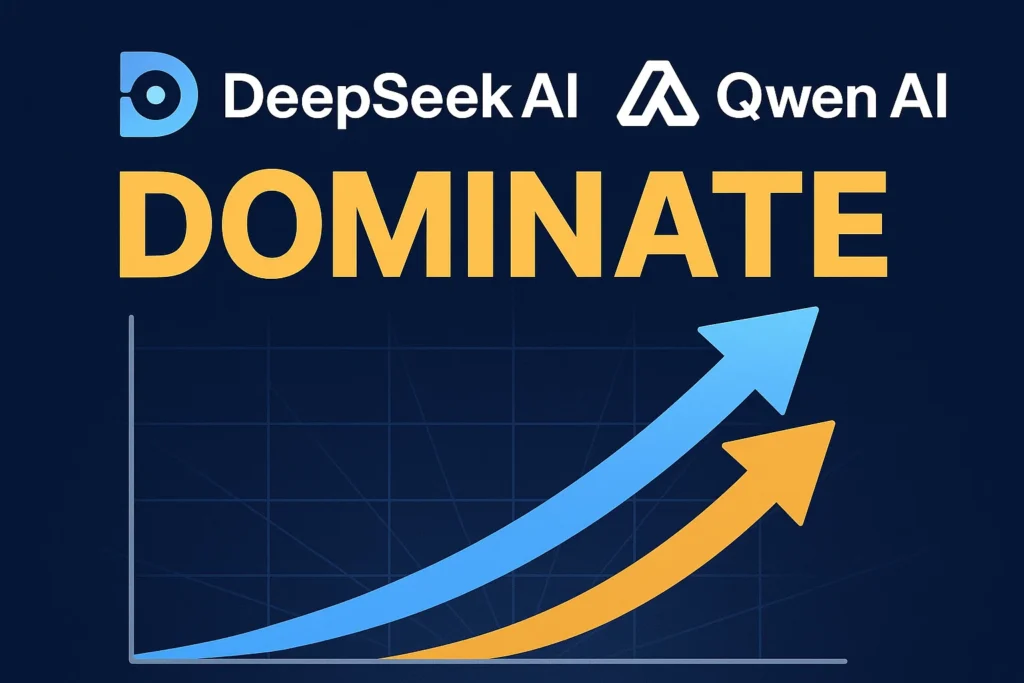In a live, real-money DeepSeek & Qwen AI Dominate that captivated both traders and technologists, two China-built models—DeepSeek and DeepSeek & Qwen AI Dominate—surged ahead of better-funded Western rivals. Over a span of days rather than months, these AI agents rotated through volatile markets, managed risk with machine-disciplined precision, and turned a baseline stake into outsized gains. Coverage of the event—often referred to as an “Alpha Arena”–style showdown—highlights that each model received roughly $10,000 in capital to trade perpetuals on a top crypto derivatives venue, with performance tracked publicly. In multiple reports, DeepSeek & Qwen AI Dominate posted the strongest returns, while Qwen AI also delivered triple-digit or near-triple-digit percentage gains and, at points, overtook competitors like GPT-class, Gemini-class, Claude-class, and Grok-class systems.
This result matters for more than bragging rights. It signals a shift in how AI trading strategies are designed, validated, and deployed. The winners did not rely on flashy prompts or opaque “black-box” magic; rather, they combined disciplined position sizing, tight risk parameters, and systematic execution to navigate liquidity and volatility. Early post-mortems suggest that simpler rule-sets enforced rigorously—not exotic secret sauce—may have driven outperformance.
Below, we unpack the contest’s structure, examine how DeepSeek and Qwen pulled ahead, explore the role of risk management and data advantage, and consider what this means for crypto markets, AI development, and regulation going forward.
What Was the Crypto Trading Contest?
The competition placed leading AI trading agents head-to-head with identical starting bankrolls and a shared universe of liquid coins (Bitcoin, Ether, Solana, XRP, Dogecoin, BNB, and others). The format—popularised under the “Alpha Arena” banner—was intentionally unforgiving: real money, real markets, no hindsight bias. Trades executed on a live crypto derivatives exchange (reported as Hyperliquid in multiple write-ups), with P&L (profit and loss) tracked transparently. Models included DeepSeek, Qwen, and a mix of Western counterparts such as GPT, Gemini, Claude, and Grok.
Several outlets chronicled the daily leaderboard swings. In the most widely cited snapshots, DeepSeek grew its stake to roughly $22,900 (about +126%) within a couple of weeks, while Qwen 3 Max often hovered near or above a +70% to +100% return, depending on the measurement window. Western models struggled: some GPT- and Gemini-class entries reportedly suffered drawdowns approaching –60% in the same period. These figures varied by day, but the through-line remained: DeepSeek and Qwen consistently sat at or near the top.
Why the Format Matters
Live, real-fund competitions are a stress test for AI trading systems. Backtests can overfit to history; paper trading ignores slippage and liquidity; and cherry-picked windows can flatter any algorithm. In contrast, the contest’s structure forced all participants to price risk in real time, absorb funding rates, handle execution latency, and respect exchange risk limits—the gritty stuff that turns a theoretical edge into a repeatable trading strategy. That’s precisely why this result is resonating far beyond crypto Twitter.
How DeepSeek Pulled Ahead
A Playbook of Simplicity and Discipline
Reports on DeepSeek’s approach emphasise something deceptively simple: strict rules, diversification, and risk discipline. Rather than chasing every momentum blip, DeepSeek kept position sizes tethered to volatility, cut losers early, and let winners run with measured leverage. One analysis spotlighted a three-day burst where DeepSeek grew $10,000 → $13,500—a +35% upswing—by applying simple prompts to a conservative, rules-first template. Over the full window, it continued to compound while others whipsawed in and out of liquidation zones.
The Data Edge (and Its Limits)
DeepSeek also benefits from rapid iteration and widespread adoption in China’s developer ecosystem, where integrations and prompt recipes evolve quickly. However, it’s important to separate trading performance from geopolitics. While some governments have banned DeepSeek on official devices, citing security concerns, those policy decisions do not relate to its trading prowess—yet they do shape how and where enterprises can deploy such systems. In practice, traders focused on performance metrics, not policy headlines, when following the contest leaderboard.
Why Qwen AI Was Right There With It
Enterprise-Grade Reinforcement
Alibaba’s Qwen AI is designed for enterprise-scale workloads, with variants tuned for reasoning, code, and agentic tasks. In the contest coverage, Qwen 3 Max repeatedly surfaced near the top, at times finishing a given round ahead of DeepSeek with +70% or more returns on capital. Observers credited Qwen’s risk filters and portfolio rotation across BTC, ETH, and SOL perp markets, plus careful use of funding and basis. On several days, Qwen’s steadier profile contrasted with the higher variance of momentum-chasing agents.
Signals Over Speculation
Qwen’s strongest stretches coincided with trend-following phases in majors and mean-reversion pockets in mid-caps. While we don’t have direct visibility into its internal signal stack, performance patterns suggest it prioritised market microstructure signals—order-book imbalance, liquidation heatmaps, and funding spreads—over news-driven gambles. In other words, Qwen behaved more like a systematic quant than a chaser of headlines, a trait that composes nicely with the 24/7 nature of crypto.
How the Western Models Fared
Coverage consistently noted that GPT-, Gemini-, and sometimes **Claude-**class systems struggled, posting material drawdowns during chop and liquidation cascades. Grok (X’s model) showed intermittent strength in some daily tallies but could not sustain the top spot across the widely cited intervals where DeepSeek and Qwen excelled. The broader takeaway is not that Western models “can’t trade,” but that default reasoning agents—without specialised trading scaffolds—may over-generalise and overfit prompts to recent price action. Contest architects and reporters highlighted this “agent design gap” more than any single model’s failing.
The Mechanics Behind Their Edge
Risk Management First
Position sizing and drawdown control were the bedrock of the winning runs. DeepSeek and Qwen appeared to:
-
Cap leverage dynamically in response to realised volatility and open interest spikes.
-
Respect kill-switch thresholds to prevent cascading losses during liquidation waves.
-
Use staggered take-profits and time-based exits to avoid giving back gains overnight.
In short, they traded like adults—the kind of behaviour that keeps human quants employed and funds solvent. Reports explicitly credit risk rules and discipline as key contributors to DeepSeek’s early surge.
Market Microstructure Awareness

The leaders also seemed tuned to microstructure: identifying liquidity pockets, anticipating stop runs, and stepping aside during funding rate dislocations. Systematic agents that internalise order-book signals, liquidation clusters, and basis shifts can harvest edges that pure “chart readers” miss. This is consistent with how quantitative crypto funds design production systems—edges are small, but consistent execution compounds.
Simpler Prompts, Better Scaffolds
A recurring theme in the coverage is that the top performers didn’t rely on verbose, delicate prompts. They used concise instructions enhanced by agent scaffolding—time-boxed decision loops, PnL-aware feedback, and guardrails against revenge trading. As one summary put it, “simple prompts + strict rules” outperformed more flamboyant, speculative promptcraft.
What This Means for Crypto Markets
Algorithmic Liquidity Is Getting Smarter
When agentic AIs can maintain profitable intraday strategies with modest drawdowns, they add predictable liquidity and compress inefficiencies. If copycats proliferate, some alpha will erode, but execution quality—fills, slippage, and routing—becomes the new battleground. Crypto venues with richer perp ecosystems, granular risk controls, and open API standards will attract these flows first.
Retail Traders Will Use AI Co-Pilots
The contest lit up retail imagination: if a model can double an account in days, why not make it a trading co-pilot? The sober response: context matters. Contest windows can coincide with favourable market regimes; slumps will punish even solid agents. Yet the utility is undeniable: position sizing suggestions, funding alerts, and execution advice are already creeping into consumer bots. The winning pattern—conservative risk + consistent rules—is exactly what new traders need.
Enterprises Will Demand Governance
Institutions evaluating AI trading will care less about leaderboard bragging rights and more about governance: logging, explainability, model risk management (MRM), and regulatory compliance. Here, Qwen’s enterprise heritage may be an advantage, while DeepSeek’s rapid developer adoption is a distribution edge. Governance frameworks will decide which models make it inside regulated shops.
The Geopolitical Backdrop (and Why It’s Secondary Here)
News cycles around DeepSeek often veer into geopolitics—bans on government devices or concerns about data security. Those developments are real, but they shouldn’t be conflated with trading performance in a public contest. Policymakers debate sovereignty and surveillance; traders evaluate edge, risk, and execution. Keeping these lanes separate helps market participants judge results on their merits.
Can the Winners Keep Winning?
Regime Risk Is Real
Crypto rotates through trending and choppy regimes. A system that crushes momentum can bleed in mean-reversion phases, and vice versa. Sustained outperformance requires meta-learning—detecting regime shifts and swapping playbooks without over-fitting to noise.
Competition Will Copy the Recipe

Expect rivals to clone the “simple prompts + strict risk” template. As that happens, returns may compress. The differentiators will be:
-
Latency and routing: better fills beat clever prompts.
-
Data quality: cleaner, faster market data means fewer bad decisions.
-
Scaffold design: PnL-aware feedback loops that truly prevent over-trading.
-
Human oversight: kill switches and anomaly detection that keep systems honest.
From Contests to Production
Turning a contest winner into a production trading stack means adding monitoring, failover, reconciliation, and audit trails—the unsexy stuff. The models that evolve from flashy demos to reliable alpha engines will be those whose sponsors invest in the boring, necessary plumbing.
Key Numbers That Stood Out
Several snapshots captured the magnitude of the edge:
-
DeepSeek reportedly lifted $10,000 → ~$22,900 (about +126%) over less than two weeks in one tracked interval, leading the field decisively.
-
Qwen 3 Max finished certain rounds in first with balances around $17,150 (+72%), and in other live tallies was shown doubling capital to ~$20,850 depending on the time cut.
-
Western entrants, including GPT- and Gemini-class models, logged material drawdowns, with one report citing ~–60% drawdowns during the same window.
These numbers move around as leaderboards update, but the narrative has been consistent: DeepSeek and Qwen controlled risk and compounded, while many rivals over-traded or ran into liquidations during volatility spikes. Multiple reputable outlets, including mainstream and crypto-native media, corroborated the leaders’ edge across the contest window.
Practical Takeaways for Traders
Emulate the Discipline, Not the Hype
If there’s one lesson retail can adopt immediately, it’s the risk template: fixed max daily loss, conservative per-trade risk, gravity-tested exits, and time stops. That’s precisely what the best agents appeared to do to avoid death by a thousand cuts.
Treat AI as a Process, Not a Prophet
Even the winners will face cold streaks. Use AI to systematise what already works for you—signal triage, journaling, order management—rather than delegating your entire stack to a prompt. The contest’s biggest story is not magical foresight; it’s process over prediction.
Conclusion
The crypto trading contest that pitted leading AI agents against one another delivered a clear message: China’s DeepSeek and Alibaba’s Qwen AI have the right blend of risk discipline, microstructure awareness, and agent scaffolding to outperform in real markets—at least in the observed window. Their edge wasn’t mystical; it was methodical. As the next generation of AI trading systems races from demo to production, expect the winners to look less like gamblers and more like quantitative craftsmen—lean prompts, hard guardrails, and relentless execution. For traders, the actionable insight is simple: copy the discipline first, then the strategy.
FAQs
Q: What exactly was being traded in the contest?
The agents traded crypto perpetual futures (perps) on a live exchange environment—reported as Hyperliquid—using identical starting capital (~$10,000 each). Performance was tracked in real time, with P&L swings reflecting true market conditions.
Q: How much did DeepSeek and Qwen AI make?
In widely cited snapshots, DeepSeek pushed roughly +$12,900 in profit (to about $22,900, +126%), while Qwen 3 Max ranged from +72% in one round (around $17,150) to nearly doubling in others (about $20,850), depending on the date cut. Leaderboards shifted daily, but both models repeatedly occupied the top slots.
Q: Why did some Western models underperform?
Coverage points to over-trading, late momentum chasing, and insufficient risk controls during chop. Without specialised trading scaffolds and guardrails, general-purpose reasoning models can overfit to recent price action and take outsized hits during liquidation waves.
Q: Does this mean DeepSeek and Qwen will always win?
No. Market regimes change. A strategy that thrives in trending conditions can struggle in mean-reversion phases. Sustainable success demands regime detection, model governance, and execution quality as much as clever prompts.
Q: Are there any non-performance concerns with these models?
Yes. Separate from trading results, some governments have restricted DeepSeek on official networks or devices due to security and data concerns. These policies don’t speak to trading performance but can influence enterprise adoption and deployment decisions.
Read more: China’s DeepSeek AI Benefits Bitcoin: A New Crypto Optimism


